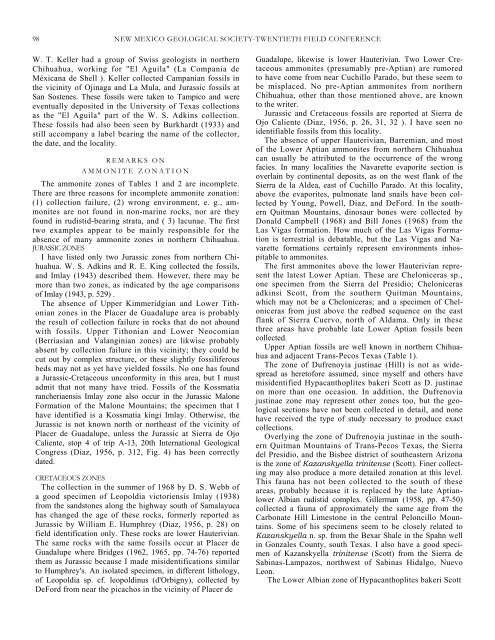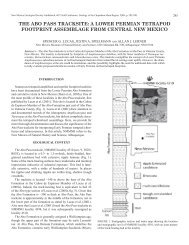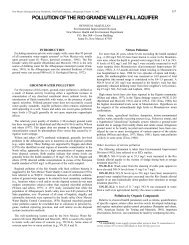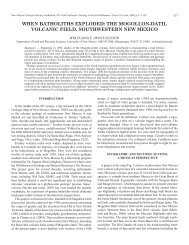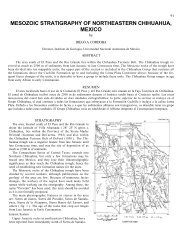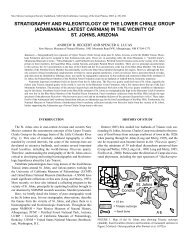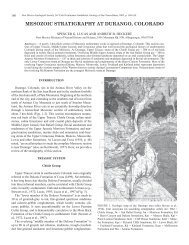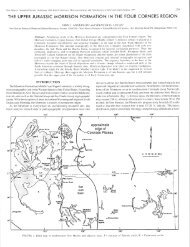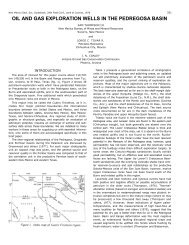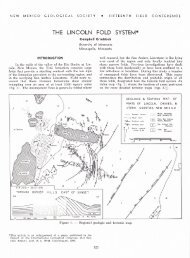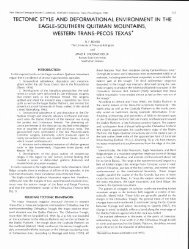Ammonite zones of northern Chihuahua - New Mexico Geological ...
Ammonite zones of northern Chihuahua - New Mexico Geological ...
Ammonite zones of northern Chihuahua - New Mexico Geological ...
You also want an ePaper? Increase the reach of your titles
YUMPU automatically turns print PDFs into web optimized ePapers that Google loves.
98 NEW MEXICO GEOLOGICAL SOCIETY-TWENTIETH FIELD CONFERENCE<br />
W. T. Keller had a group <strong>of</strong> Swiss geologists in <strong>northern</strong><br />
<strong>Chihuahua</strong>, working for "El Aguila" (La Compania de<br />
Méxicana de Shell ). Keller collected Campanian fossils in<br />
the vicinity <strong>of</strong> Ojinaga and La Mula, and Jurassic fossils at<br />
San Sostenes. These fossils were taken to Tampico and were<br />
eventually deposited in the University <strong>of</strong> Texas collections<br />
as the "El Aguila" part <strong>of</strong> the W. S. Adkins collection.<br />
These fossils had also been seen by Burkhardt (1933) and<br />
still accompany a label bearing the name <strong>of</strong> the collector,<br />
the date, and the locality.<br />
REMARKS ON<br />
AMMONITE ZONATION<br />
The ammonite <strong>zones</strong> <strong>of</strong> Tables 1 and 2 are incomplete.<br />
There are three reasons for incomplete ammonite zonation:<br />
(1) collection failure, (2) wrong environment, e. g., ammonites<br />
are not found in non-marine rocks, nor are they<br />
found in rudistid-bearing strata, and ( 3) lacunae. The first<br />
two examples appear to be mainly responsible for the<br />
absence <strong>of</strong> many ammonite <strong>zones</strong> in <strong>northern</strong> <strong>Chihuahua</strong>.<br />
JURASSIC ZONES<br />
I have listed only two Jurassic <strong>zones</strong> from <strong>northern</strong> <strong>Chihuahua</strong>.<br />
W. S. Adkins and R. E. King collected the fossils,<br />
and Imlay (1943) described them. However, there may be<br />
more than two <strong>zones</strong>, as indicated by the age comparisons<br />
<strong>of</strong> Imlay (1943, p. 529) .<br />
The absence <strong>of</strong> Upper Kimmeridgian and Lower Tithonian<br />
<strong>zones</strong> in the Placer de Guadalupe area is probably<br />
the result <strong>of</strong> collection failure in rocks that do not abound<br />
with fossils. Upper Tithonian and Lower Neocomian<br />
(Berriasian and Valanginian <strong>zones</strong>) are likwise probably<br />
absent by collection failure in this vicinity; they could be<br />
cut out by complex structure, or these slightly fossiliferous<br />
beds may not as yet have yielded fossils. No one has found<br />
a Jurassic-Cretaceous unconformity in this area, but I must<br />
admit that not many have tried. Fossils <strong>of</strong> the Kossmatia<br />
rancheriaensis Imlay zone also occur in the Jurassic Malone<br />
Formation <strong>of</strong> the Malone Mountains; the specimen that I<br />
have identified is a Kossmatia kingi Imlay. Otherwise, the<br />
Jurassic is not known north or northeast <strong>of</strong> the vicinity <strong>of</strong><br />
Placer de Guadalupe, unless the Jurassic at Sierra de Ojo<br />
Caliente, stop 4 <strong>of</strong> trip A-13, 20th International <strong>Geological</strong><br />
Congress (Diaz, 1956, p. 312, Fig. 4) has been correctly<br />
dated.<br />
CRETACEOUS ZONES<br />
The collection in the summer <strong>of</strong> 1968 by D. S. Webb <strong>of</strong><br />
a good specimen <strong>of</strong> Leopoldia victoriensis Imlay (1938)<br />
from the sandstones along the highway south <strong>of</strong> Samalayuca<br />
has changed the age <strong>of</strong> these rocks, formerly reported as<br />
Jurassic by William E. Humphrey (Diaz, 1956, p. 28) on<br />
field identification only. These rocks are lower Hauterivian.<br />
The same rocks with the same fossils occur at Placer de<br />
Guadalupe where Bridges (1962, 1965, pp. 74-76) reported<br />
them as Jurassic because I made misidentifications similar<br />
to Humphrey's. An isolated specimen, in different lithology,<br />
<strong>of</strong> Leopoldia sp. cf. leopoldinus (d'Orbigny), collected by<br />
DeFord from near the picachos in the vicinity <strong>of</strong> Placer de<br />
Guadalupe, likewise is lower Hauterivian. Two Lower Cretaceous<br />
ammonites (presumably pre-Aptian) are rumored<br />
to have come from near Cuchillo Parado, but these seem to<br />
be misplaced. No pre-Aptian ammonites from <strong>northern</strong><br />
<strong>Chihuahua</strong>, other than those mentioned above, are known<br />
to the writer.<br />
Jurassic and Cretaceous fossils are reported at Sierra de<br />
Ojo Caliente (Diaz, 1956, p. 26, 31, 32 ). I have seen no<br />
identifiable fossils from this locality.<br />
The absence <strong>of</strong> upper Hauterivian, Barremian, and most<br />
<strong>of</strong> the Lower Aptian ammonites from <strong>northern</strong> <strong>Chihuahua</strong><br />
can usually be attributed to the occurrence <strong>of</strong> the wrong<br />
facies. In many localities the Navarette evaporite section is<br />
overlain by continental deposits, as on the west flank <strong>of</strong> the<br />
Sierra de la Aldea, east <strong>of</strong> Cuchillo Parado. At this locality,<br />
above the evaporites, pulmonate land snails have been collected<br />
by Young, Powell, Diaz, and DeFord. In the southern<br />
Quitman Mountains, dinosaur bones were collected by<br />
Donald Campbell (1968) and Bill Jones (1968) from the<br />
Las Vigas formation. How much <strong>of</strong> the Las Vigas Formation<br />
is terrestrial is debatable, but the Las Vigas and Navarette<br />
formations certainly represent environments inhospitable<br />
to ammonites.<br />
The first ammonites above the lower Hauterivian represent<br />
the latest Lower Aptian. These are Cheloniceras sp.,<br />
one specimen from the Sierra del Presidio; Cheloniceras<br />
adkinsi Scott, from the southern Quitman Mountains,<br />
which may not be a Cheloniceras; and a specimen <strong>of</strong> Cheloniceras<br />
from just above the redbed sequence on the east<br />
flank <strong>of</strong> Sierra Cuervo, north <strong>of</strong> Aldama. Only in these<br />
three areas have probable late Lower Aptian fossils been<br />
collected.<br />
Upper Aptian fossils are well known in <strong>northern</strong> <strong>Chihuahua</strong><br />
and adjacent Trans-Pecos Texas (Table 1).<br />
The zone <strong>of</strong> Dufrenoyia justinae (Hill) is not as widespread<br />
as heret<strong>of</strong>ore assumed, since myself and others have<br />
misidentified Hypacanthoplites bakeri Scott as D. justinae<br />
on more than one occasion. In addition, the Dufrenovia<br />
justinae zone may represent other <strong>zones</strong> too, but the geological<br />
sections have not been collected in detail, and none<br />
have received the type <strong>of</strong> study necessary to produce exact<br />
collections.<br />
Overlying the zone <strong>of</strong> Dufrenoyia justinae in the southern<br />
Quitman Mountains <strong>of</strong> Trans-Pecos Texas, the Sierra<br />
del Presidio, and the Bisbee district <strong>of</strong> southeastern Arizona<br />
is the zone <strong>of</strong> Kazanskyella trinitense (Scott). Finer collecting<br />
may also produce a more detailed zonation at this level.<br />
This fauna has not been collected to the south <strong>of</strong> these<br />
areas, probably because it is replaced by the late Aptianlower<br />
Albian rudistid complex. Gillerman (1958, pp. 47-50)<br />
collected a fauna <strong>of</strong> approximately the same age from the<br />
Carbonate Hill Limestone in the central Peloncillo Mountains.<br />
Some <strong>of</strong> his specimens seem to be closely related to<br />
Kazanskyella n. sp. from the Bexar Shale in the Spahn well<br />
in Gonzales County, south Texas. I also have a good specimen<br />
<strong>of</strong> Kazanskyella trinitense (Scott) from the Sierra de<br />
Sabinas-Lampazos, northwest <strong>of</strong> Sabinas Hidalgo, Nuevo<br />
Leon.<br />
The Lower Albian zone <strong>of</strong> Hypacanthoplites bakeri Scott


